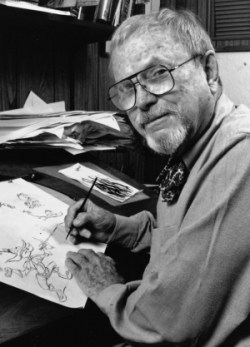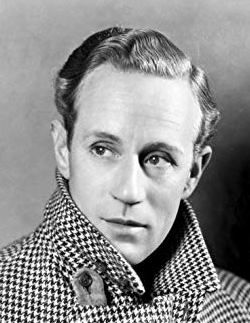 This is different from my normal Director’s Lists as Jones is not known for features, but for animated shorts. But then he’s also the greatest director of shorts, and arguably of animations of any length, so definitely a man who needs to be included.
This is different from my normal Director’s Lists as Jones is not known for features, but for animated shorts. But then he’s also the greatest director of shorts, and arguably of animations of any length, so definitely a man who needs to be included.
A majority of his career was spent at Warner Bros., working on Loony Tunes/Merrie Melodies. He created Roadrunner and Wile E. Coyote, as well as Pepé Le Pew, but his greatest achievements were with Bugs Bunny and Daffy Duck, shifting Bugs and wildly changing Daffy away from their chaotic, loony origins. Jones also focused on the music, using it not just for background or emphasis, but using it as the story, and no one did it better. Some of the praise must go to writer Michael Maltese, with whom he often collaborated.
My list is almost all Warner Bros. cartoons (it would be completely so if I didn’t cheat and include one work that didn’t have a theatrical release), but then Jones himself said his best work was for Warners. This list can also be used as a Best of Looney Tunes/Merrie Melodies, as my top 10 of those would be the Jones films below with the addition of one Robert McKimson (Hillbilly Hare) to replace the non-WB film, though in a numerically higher slot.
As always, a few Honorable Mentions: Firstly, For Scent-imental Reasons (1949), as I needed one Pepé Le Pew film, and this one won an Academy Award; then one for The Scarlet Pumpernickel (1950), an all out Daffy extravaganza; and finally High Note (1960), a musical short where the notes on a sheet of music come alive, and one gets drunk.
And as there are so many films (and as Jones created more masterpieces than any other director of any kind), I’m making this a list of 10 instead of my normal 8.
#10 – Hair-Raising Hare (1946) — “Monster’s are such interesting people.” With a castle, “Peter Lorre,” and Gossamer, this is a must for every Halloween.
#9 – Long-Haired Hare (1949) — The first of three opera-related films on this list, with Bugs declaring war on an unpleasant opera singer. The long-note prank is an all-time classic. And yeah, we get an America v Europe metaphor here.
#8 – Duck Dodgers in the 24½th Century (1953) — A parody of Buck Rogers, with Daffy fighting Marvin the Martian. My favorite use of Porky as Daffy’s smarter sidekick. This is a masterwork based on set design alone.
#7 – The Hunting Trilogy (1951-1953) [Rabbit Fire (1951), Rabbit Seasoning (1952), Duck! Rabbit, Duck! (1953)] — “Pronoun trouble.” Is it duck season or rabbit season? This is the iconic Bugs v Daffy conflict, and while Bugs mostly wins, the films belong to Daffy and his reactions. A bit of a cheat, but if I take one of them, I want them all.
#6 – Rabbit of Seville (1950) — The second opera cartoon on this list, with Elmer chasing Bugs onto a stage. It’s non-stop physical comedy combined with some great musical gags. How many kids’ interest in classical music started here?
#5 – Feed the Kitty (1952) — How do you get so much emotion into a 7 min animation? The kitten is adorable, and the dog is relatable. This was Eugie’s favorite cartoon.
#4 – How the Grinch Stole Christmas (1966) — My second cheat on this list as this is a TV special. It’s also the only version of this story you need to watch. The lines are great, the songs memorable, and Boris Karloff owns it.
#3 – Duck Amuck (1953) — One brilliant joke after another, while also giving us top notch character work, and, if you want it, enough philosophical ponderings to fill a college class. What is reality anyway?
#2 – One Froggy Evening (1955) — A musical animation (though only with a little opera this time) that’s a parable on greed told through a singing and dancing frog. This may be the cruelest of the Looney Tunes/Merrie Melodies.
#1 – What’s Opera, Doc? (1957) — My choice for the pinnacle of animation, it has Elmer hunting Bugs, in full Wagnerian opera-mode, and Wagner has never been better. I can’t choose what works best: the opera(s) parody, the wild gags, or Elmer’s sadness when he finally gets what he’s always wanted. This is perfection.

 Howard was a major star of early film, and a gifted actor, playing romantics, egotists, detectives, scholars, and even a swashbuckler, but he is primarily remembered for his gruesome role as the effete Ashley in Gone With the Wind. His legacy deserves better. Hollywood never quite figured out what to do with him. He was handsome, with a fine clear British accent, but he didn’t fit into the newly developing molds.
Howard was a major star of early film, and a gifted actor, playing romantics, egotists, detectives, scholars, and even a swashbuckler, but he is primarily remembered for his gruesome role as the effete Ashley in Gone With the Wind. His legacy deserves better. Hollywood never quite figured out what to do with him. He was handsome, with a fine clear British accent, but he didn’t fit into the newly developing molds.